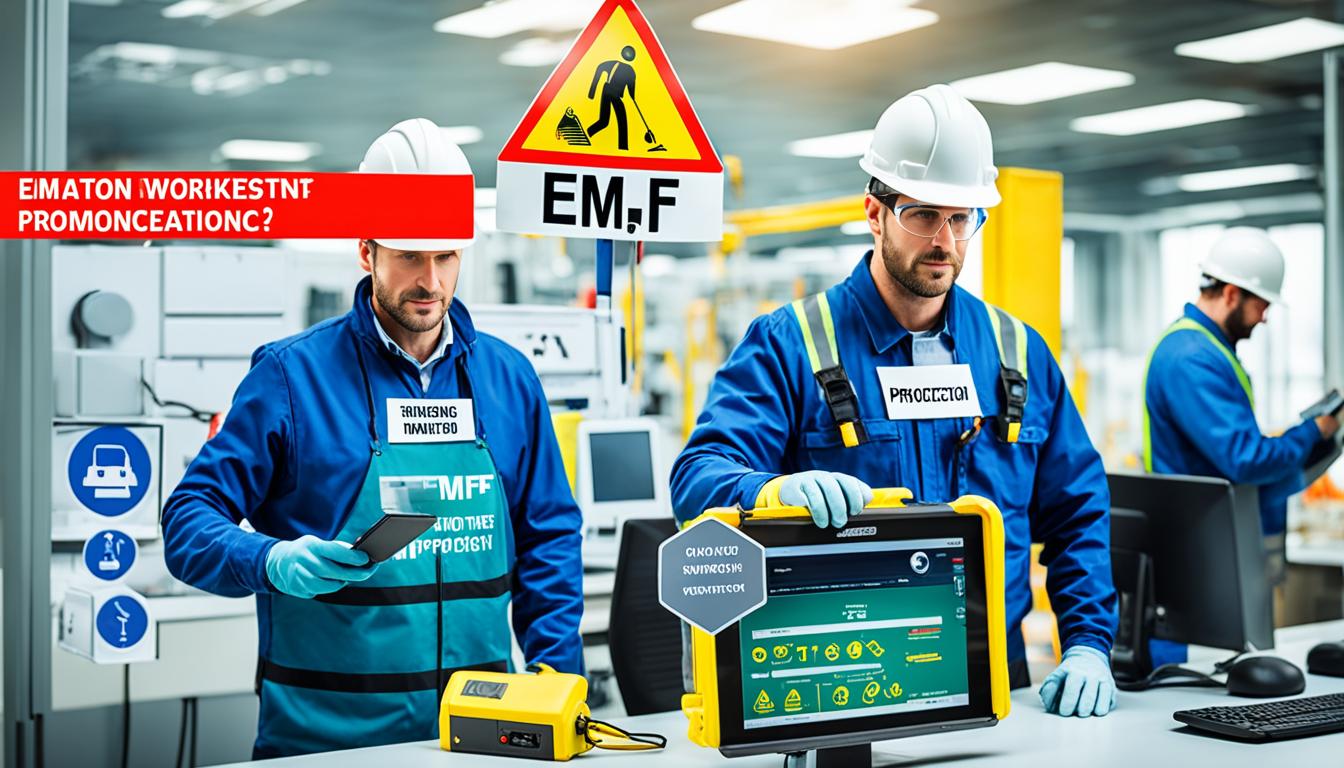Disclosure: This Post Contains Affiliate Links; We earn a commission on purchases.
Employers need to prioritize compliance and safety when it comes to electromagnetic fields (EMFs) in the workplace. Various industries, including telecommunications, healthcare, transport, engineering, broadcasting, and energy distribution, are particularly at risk for EMF exposure. Understanding and adhering to workplace EMF regulations is crucial to safeguarding employees from potential health risks.
Workplace EMF regulations encompass several key aspects, such as assessing EMF levels, ensuring exposure limits are not exceeded, providing information and training to employees, and implementing action plans when necessary. By implementing these measures, employers can effectively protect their workforce and create a safe working environment.
EMF exposure limits should be closely monitored to prevent any adverse health effects. Employers should also consider implementing workplace EMF protection measures to minimize risks associated with EMFs. This may include the use of shielding devices or modifying work processes to reduce exposure.
Additionally, providing comprehensive EMF safety training to employees is essential. This training equips them with the knowledge and skills to identify potential hazards, understand EMF regulations, and adopt safe practices when working with EMF-producing equipment.
Key Takeaways
- EMF compliance and safety are crucial in protecting employees from potential health risks in the workplace.
- Industries such as telecommunications, healthcare, and transport are particularly at risk for EMF exposure.
- Workplace EMF regulations include assessing EMF levels, ensuring exposure limits are not exceeded, providing information and training, and implementing action plans.
- Monitoring and managing EMF exposure limits is important to prevent adverse health effects.
- Implementing workplace EMF protection measures can help minimize risks associated with EMF exposure.
Understanding EMFs and Their Dangers
Electromagnetic fields (EMFs) are present in both natural and man-made sources. Natural sources encompass the Earth’s magnetic field and electric charges generated during thunderstorms. On the other hand, human-made sources of EMFs include widespread electronic devices such as electric wiring, mobile phones, power tools, display screens, TV antennas, and X-ray machines in hospitals.
The potential health risks associated with EMFs depend on the intensity and frequency range of the electromagnetic field. Effects can range from sensory symptoms like nausea and vertigo to potential nerve stimulation and thermal stress. To ensure occupational EMF safety, it is crucial for employers to assess and understand the dangers posed by EMFs in the workplace.
Risk assessments and guidelines provided by occupational health and safety authorities offer valuable insights into the potential hazards of EMFs. By conducting thorough risk assessments, employers can identify areas of concern and implement appropriate safety measures. This proactive approach aids in safeguarding employees from EMF-related health risks.
EMF safety training and occupational EMF guidelines are also essential components in maintaining a safe working environment.
| Dangers of EMFs | Effects |
|---|---|
| Sensory symptoms | Include nausea and vertigo |
| Nerve stimulation | Potential repercussions for the nervous system |
| Thermal stress | Possible impact on body temperature regulation |
EMF Laws and Regulations
In the United Kingdom, employers are required to adhere to specific laws and regulations to ensure workplace safety regarding electromagnetic fields (EMFs). The primary legislation that addresses EMFs in the workplace is The Control of Electromagnetic Fields at Work Regulations 2016 (CEMFAW). Compliance with CEMFAW is crucial for employers to protect their employees from excessive EMF exposure and maintain workplace EMF standards.
Under CEMFAW, employers have several key responsibilities, including:
- Assessing EMF levels in the workplace to identify potential risks and determine appropriate protective measures.
- Ensuring that exposure limits set by the regulations are not exceeded to prevent adverse health effects.
- Providing employees with relevant information and training on EMFs and their potential risks.
- Implementing action plans to address any EMF-related issues or hazards identified in the workplace.
It is important to note that CEMFAW is just one component of the broader workplace health and safety laws in the United Kingdom. The Management of Health and Safety at Work Regulations 1999 establishes the framework for ensuring the health and safety of employees in various aspects, including EMF protection.
Workplace Health and Safety Laws
The Management of Health and Safety at Work Regulations 1999 sets out the general duties that employers must follow to ensure the health and safety of their employees. These regulations encompass various aspects of workplace safety, including the management of EMF exposure. Compliance with these regulations is the foundation for maintaining a safe and healthy working environment for all employees.
Compliance and Protection
Compliance with both CEMFAW and the broader workplace health and safety laws is essential for employers to protect their employees from the potential health risks associated with EMFs. By assessing EMF levels, implementing protective measures, providing information and training, and having action plans in place, employers can ensure that their workplaces meet EMF standards and prioritize the well-being of their employees.

| Regulations | Responsibilities |
|---|---|
| The Control of Electromagnetic Fields at Work Regulations 2016 (CEMFAW) |
|
| Management of Health and Safety at Work Regulations 1999 | Comprehensive workplace health and safety laws, including EMF protection |
EMF Training and Risk Assessment
Employers have a responsibility to ensure the safety and well-being of their employees who are regularly exposed to electromagnetic fields (EMFs) in the workplace. One crucial step in achieving this is by providing EMF safety training to employees. This training equips them with the knowledge and skills needed to work safely around EMF-producing equipment and adhere to EMF regulations.
During EMF safety training, employees will learn about the potential risks associated with EMFs, how to identify potential sources of EMFs in their workspace, and the proper precautions to take to minimize exposure. They will also be educated on the importance of using personal protective equipment and following established workplace protocols.
Conducting risk assessments specific to EMFs is another essential aspect of ensuring workplace safety. These assessments help identify potential hazards, evaluate exposure levels, and determine the effectiveness of existing control measures. Factors such as the presence of multiple sources of EMFs and the vulnerability of certain individuals, such as expectant mothers or those with implanted medical devices, should be taken into account during the assessment process.
By conducting thorough risk assessments, employers can implement appropriate control measures, such as shielding, relocation of equipment, or adjustment of work schedules, to minimize the potential health risks associated with EMFs. These measures should align with the EMF workplace standards and guidelines specified by regulatory authorities.
It is important to note that EMF safety training and risk assessment are ongoing processes. As technology advances and new equipment is introduced into the workplace, employers must stay updated on the latest EMF workplace standards and regulations to ensure the continued safety of their employees.
To summarize, EMF safety training and risk assessment play a crucial role in safeguarding employees from potential health risks associated with EMFs in the workplace. By providing comprehensive training and regularly assessing and controlling EMF exposure, employers can create a safe working environment that prioritizes employee well-being.
Table: EMF Training and Risk Assessment Checklist
| Step | Actions |
|---|---|
| 1 | Identify employees regularly exposed to EMFs |
| 2 | Provide comprehensive EMF safety training |
| 3 | Conduct risk assessments specific to EMFs |
| 4 | Evaluate exposure levels and potential hazards |
| 5 | Implement control measures according to EMF workplace standards |
| 6 | Regularly update training and reassess risk |

Conclusion
EMF compliance and safety are paramount for protecting employees from potential health risks in the workplace. Industries with a higher risk of EMF exposure, such as telecommunications, healthcare, and transport, should prioritize implementing effective workplace EMF protection measures and providing comprehensive safety training.
By adhering to EMF regulations, conducting thorough risk assessments, and ensuring proper information and training, employers can create a safe working environment. Regular updates on EMF workplace standards are crucial to staying informed and taking necessary action to protect employees from excessive EMF exposure.
EMF safety awareness should be a top priority for employers across various industries. Taking proactive steps to evaluate and mitigate EMF risks is vital in safeguarding the well-being of employees and promoting a culture of safety in the workplace. By investing in EMF compliance and safety, employers demonstrate their commitment to creating a healthy work environment for their workforce.
Source Links
- https://www.sor.org/getmedia/c83a4f3a-a56e-4c0a-9a3a-4fe3fd2317d8/hsg281.pdf
- https://praxis42.com/resources/emf-rf/what-is-emf-and-the-importance-of-emf-safety-awareness/
- https://www.yorkemc.com/2018/08/07/emf-surveys-in-the-workplace-what-you-need-to-know/

Subscribe to Our Newsletter








